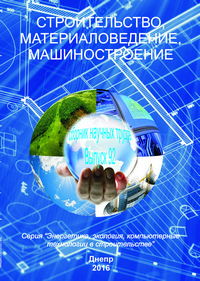Residual stresses and strains in the pipe after the pre–bending and local heating
Keywords:
large–diameter pipe, thermomechanical loading, residual stresses.Abstract
Annotation. Constructional elements made from bent steel pipes are widely used in chemical and aerospace sectors, civil engineering, the construction of pipelines and utility networks. Industrial bending machines are commonly used for bending pipes. However, for large pipe diameters and thicknesses such large machines cannot be used. Moreover, these are expensive machines and their use for bending pipe is not rational in a small volume. Because of this, the task of analyzing the effectiveness of the simpler ways to bend pipes is relevant, e.g. applying bending moment and local heating effect simultaneously. Thus, the purpose of the article is to build a model that allows to analyze bending of locally heated large–diameter pipe, when it is loaded by bending moment. Method of research consists of building of models of pipe bend by using the finite element method when the bending moment and local heating effect on the predetermined area are applied. Finite element model of the deformation of locally heated pipes that are bended by bending moment was built in software package ABAQUS. The mechanical behavior of the pipe material was described by the theory of ideal–plastic flow with a yield strength, which depends on the temperature. Scientific novelty lies in the fact that the model allows to determine the residual state of the pipe with specified geometric dimensions for a given program of thermopower loading. The constructed model has practical importance in the field of engineering calculations, which are used in the manufacture of building structures with curved large–diameter pipes. This allows to select the optimum configuration of the heated area and the loading mode to achieve the desired bending of the pipe when the restriction on the change of the wall thickness and cross–sectional ovalization are satisfied.References
Kachanov L. M. Osnovy teorii plastychnosti [Fundamentals of the Theory of Plasticity]. M.: izd–vo Tekh– teor lit., 1956. 324 p. (in Russia)
Merzlyakov V. A. Upruhoplastycheskoe deformyrovanye obolochek vrashchenyya pry neosesymmetrychnom nahruzhenyy [Elastoplastic deformation of shells of revolution under axisymmetrical loading]. (Obzor) / V.A. Merzlyakov, Yu.N. Shevchenko // Prykl. mekh. 1999, №5, P.3–39. (in Russia)
Nyshta A. P., Skvortsov A.N. Konechno-elementnoe modelirovanie napriazhennoho sostoyaniia horyachehnutoho otvoda proyzvodstva ooo «neftehazdetal» [Finite element modeling of the stress state of a hot bending pipe produced by LLC "neftegazdetal"]. Intellektualnye systemy v proizvodstve., 2013., № 2 (22).(in Russia)
Asao H., K. Okada, M. Watanabe, H. Matsumoto and N. Umeharea, Analysis in workability of pipe bending using high frequency induction heating. Proceedings of The Twenty – Fourthth International Machine Tool design and Research Conference, 1983, p. 97–104.
Asao H., Okada K., Fujishima S., Matsumoto T., Numerical analysis of bending force in tube bending using frequency induction heating–investigation of metal forming local heating. I, J. JSTP, 28 (313) 1987, p.150–157.
Behne T. A new bending technique for large diameter pipe. IAMI, 1, 1983, 34.
Chen J., Young B., Uy B. Behavior of High Strength Structural Steel at Elevated Temperatures. Journal of Structural Engineering, 2006, 132(12), p. 1948–1954.
Guo L., Yang S., Jiao H. Behavior of thin–walled circular hollow section tube subjected to bending. Thin–Walled Structures, 73, 2013, p. 281–289.
Hea Y., Henga L., Zhiyonga Z., Meia Z., Jinga L., Guangjunb L. Advances and Trends on Tube Bending Forming Technologies. Chinese Journal of Aeronautics, 25, 2012, p. 1–12.
Hu Z., Li J.Q. Computer Simulation of Pipe–bending Processes with Small Bending Radius Using Local Induction Heating. Journal of Materials Processing Technology, 91, 1999, p. 75–79.
Orcan Y., Eraslan A. N. Thermal stresses in elastic–plastic tubes with temperature–dependent mechanical and thermal properties. Journal of Thermal stresses, 2001, V. 24, №11, P. l097–1113.
Panchal D. D. and Patel A.M. Experimental Investigations in Pipe Bending Methods: A Literature Review. International Journal of Advanced Research (2016), V. 4, Is. 4, p.77–81.
Wang Z. T., Hu Z. Theory of pipe-bending to a small bend radius using induction heating. J. Mater. Process. Technol., 21, 1990, 275–284.
Xu Y., Zhang S., Cheng M., Song H., Zhang X. Application of pulsating hydroforming in manufacture of engine cradle of austenitic stainless steel. Procedia Engineering, 81, 2014, p. 2205 – 2210
Downloads
Published
Issue
Section
License
Редакція Видання категорично засуджує прояви плагіату в статтях та вживає всіх можливих заходів для його недопущення. Плагіат розглядається як форма порушення авторських прав і наукової етики.
При виявлені у статті більш ніж 25% запозиченого тексту без відповідних посилань та використання лапок, стаття кваліфікується як така, що містить плагіат. У цьому випадку стаття більше не розглядається редакцією, а автор отримує перше попередження.
Автори, в статтях яких повторно виявлено плагіат, не зможуть публікуватися в усіх журналах Видавництва ДВНЗ «Придніпровська державна академія будівництва та архітектури».
Автори, які публікуються у цьому журналі, погоджуються з наступними умовами:
- Автори залишають за собою право на авторство своєї роботи та передають журналу право першої публікації цієї роботи на умовах ліцензії Creative Commons Attribution License, котра дозволяє іншим особам вільно розповсюджувати опубліковану роботу з обов'язковим посиланням на авторів оригінальної роботи та першу публікацію роботи у цьому журналі.
- Автори мають право укладати самостійні додаткові угоди щодо неексклюзивного розповсюдження роботи у тому вигляді, в якому вона була опублікована цим журналом (наприклад, розміщувати роботу в електронному сховищі установи або публікувати у складі монографії), за умови збереження посилання на першу публікацію роботи у цьому журналі.
- Політика журналу дозволяє і заохочує розміщення авторами в мережі Інтернет (наприклад, у сховищах установ або на особистих веб-сайтах) рукопису роботи, як до подання цього рукопису до редакції, так і під час його редакційного опрацювання, оскільки це сприяє виникненню продуктивної наукової дискусії та позитивно позначається на оперативності та динаміці цитування опублікованої роботи (див. The Effect of Open Access).

